[PHP Learning] Data Types of PHP7
Variable name in PHP → zval, variable value → zend_value. Its variable memory is managed through reference counting. In PHP7, the reference counting is in the value structure.
Variable type:
Header file is implemented internally in PHP source code/zend/zend_types.h
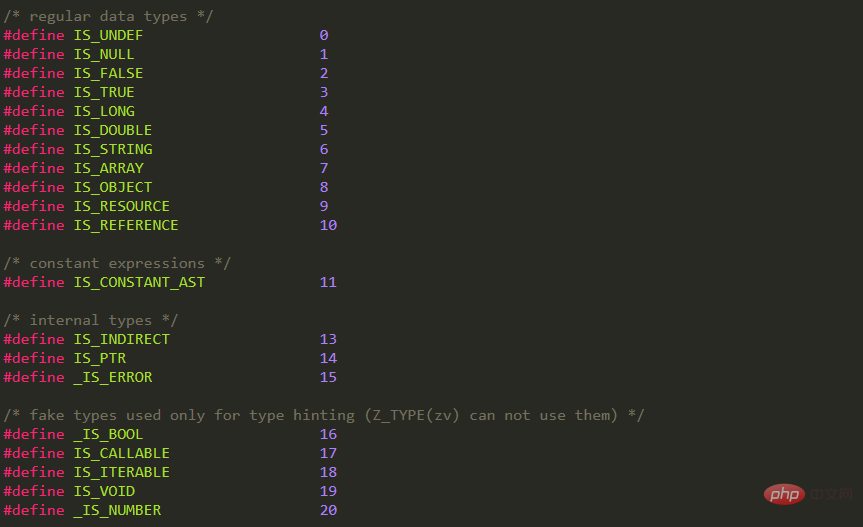

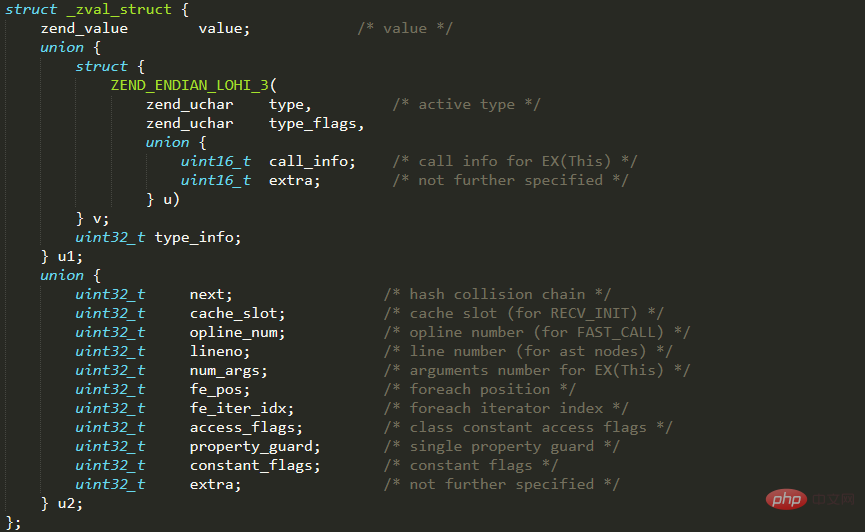 ## zend_value is a union, its code is as follows:
## zend_value is a union, its code is as follows:
 ast Types such as , ptr, and zv are only used by the kernel itself.
ast Types such as , ptr, and zv are only used by the kernel itself.
String:
PHP defines a separate structure for strings: zend_string. In zend_value, str points to the specific structure.


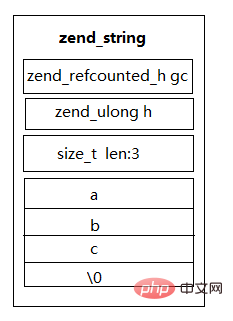
The val that stores the string content is special.
val does not use the char* type. When allocating a string, it is operated like this: malloc(sizeof(zend_sting) string length), which means that more memory will be allocated to store the string content. This block The starting position of the extra memory is val.
The advantage of this is that it can save one memory allocation (char*) and is more helpful for memory management.
The extra byte in val (val[1] instead of val[0] in the structure) is used to store the last character "\0" of the stored string.
For example $a="abc", the corresponding zend_string memory structure is as shown on the left:
Array:

 ##nTableMask:
##nTableMask:
nNumUsed, nNumOfElements:
When deleting an array element, it will not be deleted from the array immediately. Instead, the type of the element will be marked as IS_UNDEF. It will only be used when the array capacity exceeds the limit and needs to be expanded. will be deleted only then.If there is no expansion, nNumUsed will always increase, so its value is not a valid number of elements. nNumOfElements is the number of valid elements in the array, so nNumOfElements ≤ nNumUsed.
Bucket
The structure stores the key and value of the element. And h is the hash code: if the key is a numerical value (and numerical index), then its value is the value of the numerical index; if the key is a string, then its value is the hash value calculated by the Time33 algorithm based on the string key. The h value is used to map the storage location of the element.
Array implementation: 
 Hash function:
Hash function:
This intermediate mapping table is not found in the structure of the PHP array. In fact, it is placed together with arData. When the array is initialized, the memory used to store the Bucket is allocated and the same amount of space of uint32_t size is allocated at the same time. Then offset arData to the location where the array of elements is stored.
The intermediate mapping table can be accessed forward through arData. Hash conflict:
Hash conflict:
Solution: String the conflicting Buckets into a linked list, that is, the intermediate mapping table maps out a Bucket linked list, not a Bucket. When searching, you need to traverse this linked list and compare keys one by one to find the target element.
HashTable will record the storage location of the elements that conflict with it in the arData array.

When setting the mapping value, it is found that the position to be set in the intermediate mapping table has been occupied by the previously inserted element (the value is not equal to the initialized -1), then it will Save the existing value to the newly inserted Bucket (that is, u2.next=0 after c is inserted), and then update the value in the mapping table to the storage location of the new Bucket (that is, the value in the mapping table: 2).
Reference:
A reference is a structure that points to other types, similar to the concept of pointers in C language. When a reference type variable is modified, the modification will be reflected in the actual referenced variable.
In PHP, a reference variable is generated through the & operator, such as $b = &$a. During execution, a zend_reference structure is first allocated to the variable of the & operation. This structure is a reference type structure. A zval is embedded, and the value of this zval points to the value of the original zval. Then the type of the original zval is modified to IS_REFERENCE, and the value of the original zval points to the newly created zend_reference structure.


Example:
$a = date("Y-m");$b = &$a;$a is a string, through & $a converts it into a reference type and assigns it to $b. After conversion, the type of $a changes from IS_STRING to IS_REFERENCE, and the value of $a is also converted into a zend_reference structure, which points to the original string.
$a and $b indirectly point to the actual value.
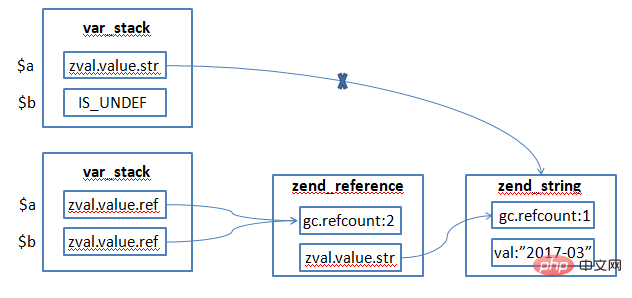
You need to pay attention when using references. References can only be generated through & and cannot be passed through assignment.
As in the above example, if $b is assigned to other variables, then the value passed to the new variable will be the value of the actual reference, not the reference itself.
$a = date("Y-m");$b = &$a;$c = $b; //如果想让$c也引用指向$a/$b引用的值,则:$c = &$b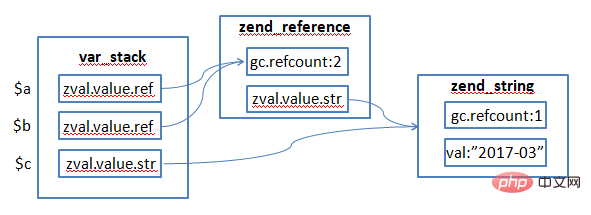
Recommended course: PHP video tutorial
The above is the detailed content of [PHP Learning] Data Types of PHP7. For more information, please follow other related articles on the PHP Chinese website!

Hot AI Tools

Undresser.AI Undress
AI-powered app for creating realistic nude photos

AI Clothes Remover
Online AI tool for removing clothes from photos.

Undress AI Tool
Undress images for free

Clothoff.io
AI clothes remover

AI Hentai Generator
Generate AI Hentai for free.

Hot Article

Hot Tools

Notepad++7.3.1
Easy-to-use and free code editor

SublimeText3 Chinese version
Chinese version, very easy to use

Zend Studio 13.0.1
Powerful PHP integrated development environment

Dreamweaver CS6
Visual web development tools

SublimeText3 Mac version
God-level code editing software (SublimeText3)

Hot Topics
 What data type should be used for gender field in MySQL database?
Mar 14, 2024 pm 01:21 PM
What data type should be used for gender field in MySQL database?
Mar 14, 2024 pm 01:21 PM
In a MySQL database, gender fields can usually be stored using the ENUM type. ENUM is an enumeration type that allows us to select one as the value of a field from a set of predefined values. ENUM is a good choice when representing a fixed and limited option like gender. Let's look at a specific code example: Suppose we have a table called "users" that contains user information, including gender. Now we want to create a field for gender, we can design the table structure like this: CRE
 What is the best data type for gender fields in MySQL?
Mar 15, 2024 am 10:24 AM
What is the best data type for gender fields in MySQL?
Mar 15, 2024 am 10:24 AM
In MySQL, the most suitable data type for gender fields is the ENUM enumeration type. The ENUM enumeration type is a data type that allows the definition of a set of possible values. The gender field is suitable for using the ENUM type because gender usually only has two values, namely male and female. Next, I will use specific code examples to show how to create a gender field in MySQL and use the ENUM enumeration type to store gender information. The following are the steps: First, create a table named users in MySQL, including
 Mind map of Python syntax: in-depth understanding of code structure
Feb 21, 2024 am 09:00 AM
Mind map of Python syntax: in-depth understanding of code structure
Feb 21, 2024 am 09:00 AM
Python is widely used in a wide range of fields with its simple and easy-to-read syntax. It is crucial to master the basic structure of Python syntax, both to improve programming efficiency and to gain a deep understanding of how the code works. To this end, this article provides a comprehensive mind map detailing various aspects of Python syntax. Variables and Data Types Variables are containers used to store data in Python. The mind map shows common Python data types, including integers, floating point numbers, strings, Boolean values, and lists. Each data type has its own characteristics and operation methods. Operators Operators are used to perform various operations on data types. The mind map covers the different operator types in Python, such as arithmetic operators, ratio
 What should I do if the plug-in is installed in php7.0 but it still shows that it is not installed?
Apr 02, 2024 pm 07:39 PM
What should I do if the plug-in is installed in php7.0 but it still shows that it is not installed?
Apr 02, 2024 pm 07:39 PM
To resolve the plugin not showing installed issue in PHP 7.0: Check the plugin configuration and enable the plugin. Restart PHP to apply configuration changes. Check the plugin file permissions to make sure they are correct. Install missing dependencies to ensure the plugin functions properly. If all other steps fail, rebuild PHP. Other possible causes include incompatible plugin versions, loading the wrong version, or PHP configuration issues.
 What is the best data type choice for gender field in MySQL?
Mar 14, 2024 pm 01:24 PM
What is the best data type choice for gender field in MySQL?
Mar 14, 2024 pm 01:24 PM
When designing database tables, choosing the appropriate data type is very important for performance optimization and data storage efficiency. In the MySQL database, there is really no so-called best choice for the data type to store the gender field, because the gender field generally only has two values: male or female. But for efficiency and space saving, we can choose a suitable data type to store the gender field. In MySQL, the most commonly used data type to store gender fields is the enumeration type. An enumeration type is a data type that can limit the value of a field to a limited set.
 Detailed explanation of how to use Boolean type in MySQL
Mar 15, 2024 am 11:45 AM
Detailed explanation of how to use Boolean type in MySQL
Mar 15, 2024 am 11:45 AM
Detailed explanation of how to use Boolean types in MySQL MySQL is a commonly used relational database management system. In practical applications, it is often necessary to use Boolean types to represent logical true and false values. There are two representation methods of Boolean type in MySQL: TINYINT(1) and BOOL. This article will introduce in detail the use of Boolean types in MySQL, including the definition, assignment, query and modification of Boolean types, and explain it with specific code examples. 1. The Boolean type is defined in MySQL and can be
 Python entry to proficiency: from zero basics to project development
Feb 20, 2024 am 11:42 AM
Python entry to proficiency: from zero basics to project development
Feb 20, 2024 am 11:42 AM
1. Introduction to Python Python is a general-purpose programming language that is easy to learn and powerful. It was created by Guido van Rossum in 1991. Python's design philosophy emphasizes code readability and provides developers with rich libraries and tools to help them build various applications quickly and efficiently. 2. Python basic syntax The basic syntax of Python is similar to other programming languages, including variables, data types, operators, control flow statements, etc. Variables are used to store data. Data types define the data types that variables can store. Operators are used to perform various operations on data. Control flow statements are used to control the execution flow of the program. 3.Python data types in Python
 Introduction to basic syntax and data types of C language
Mar 18, 2024 pm 04:03 PM
Introduction to basic syntax and data types of C language
Mar 18, 2024 pm 04:03 PM
C language is a widely used computer programming language that is efficient, flexible and powerful. To be proficient in programming in C language, you first need to understand its basic syntax and data types. This article will introduce the basic syntax and data types of C language and give examples. 1. Basic syntax 1.1 Comments In C language, comments can be used to explain the code to facilitate understanding and maintenance. Comments can be divided into single-line comments and multi-line comments. //This is a single-line comment/*This is a multi-line comment*/1.2 Keyword C language






